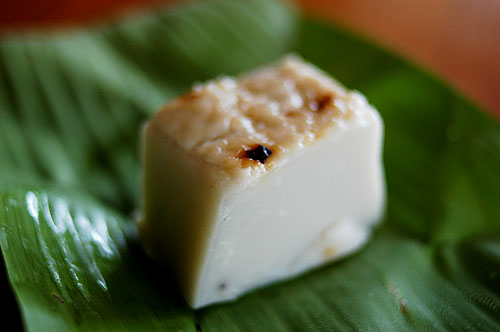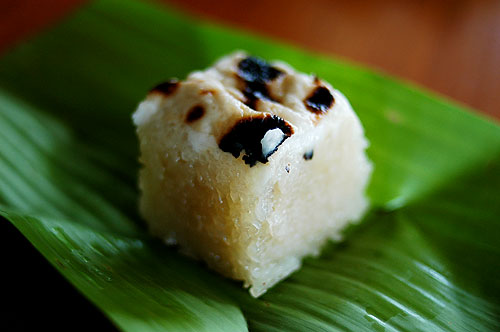 I'll let you in on a little secret: Of the chefs assembled here for the Four Seasons Bangkok World Gourmet Festival, Chef Christine Manfield is easily the loveliest. And up to this point at least, I reckon that her dinner has been the tastiest. But more on that in a minute.
I'll let you in on a little secret: Of the chefs assembled here for the Four Seasons Bangkok World Gourmet Festival, Chef Christine Manfield is easily the loveliest. And up to this point at least, I reckon that her dinner has been the tastiest. But more on that in a minute.

Manfield, a native of Australia whose current outpost is the Sydney restaurant Universal, is a longstanding proponent of drawing tastes and flavours from disparate cuisines. I spent a bit of time in her kitchen leading up to her dinner (more on that to come soon) and was blown away by the diversity of ingredients she was using. Some of her vegetables seemed most likely to be bound for David Thompson's Thai meal, while some of the spices she used made the kitchen smell as if we were in Tunis or Marrakesh.
Previous to Thursday night's dinner, I had the opportunity to chat with Manfield about Australian cuisine, writing, her eclectic palate and love of travel, excerpts of which are below:
AB: In talking with Australians, I often get the impression that Asian food is perceived as an essential part of what people today consider Australian Cuisine. Would you say that this is accurate?
CM: Absolutely. Because there were so many Chinese miners in the past, every tinpot town in Australia has a Chinese restaurant. The food wasn't always good, but it's always been with us. The shift happened over the last 20 years, and was a result of immigration and the fact that so many Australians travel. We've become used to this diversity, and now are even starting to appreciate the regional differences in Asian food.
AB: Do you plan to incorporate any Thai flavours or ingredients while here in Bangkok?
CM: Half of my repertoire stems from Thai food -- fish sauce is my salt. When I was in London, we used to get excellent Thai ingredients. In Australia it's more limited as we're on island and there are lots of restrictions. When I'm here I like to use palm sugar, it's like caramel. Som saa, which is like lime, orange and kaffir lime combined, is another I like to use. I like dishes that look simple, but at the same time, have highly refined flavours. You should be able to taste every flavour in a dish.
AB: Other than simply a source of inspiration for recipes, travel appears to play a central role in your life.
CM: I spend half my year traveling. Last year I went on 14 overseas trips! I take my staff abroad and lead culinary tours. I think young people should be required to travel abroad.
AB: Cooking is often perceived as a physical, rather than an intellectual endeavour, yet you and fellow Australian chef David Thompson are known as much for your writing as your restaurants. Why write?
CM: For me, a cookbook isn't just a list of recipes. I come from an intellectual background and for me, cooking is about feeding my brain. I have a huge cookbook library and encourage my staff to read.
Now to the meal. For those here in Thailand, I thought that it was no stretch to find similarities between Manfield's dishes and the native cuisine. As she mentions above, the flavours were generally strong, independent and crystal clear, and she also didn't seem afraid to employ a bit of spice and salt. The first course, Dry aged beef tataki, pomegranate and pickled beetroot, did a great job of setting the pace for the entire meal:
 Chef Christine Manfield's Dry aged beef tataki, pomegranate and pickled beetroot
Chef Christine Manfield's Dry aged beef tataki, pomegranate and pickled beetroot
The slices of beef were rich and moreish, and contrasted with the acidic, fruity flavours of the pomegranate, starfruit, beetroot and citrus. The meaty and acidic elements were bound together by a slightly sweet/sour onion chutney. The result was a dish that, even if it had been the only dish of the night, would have left most of us feeling mighty satisfied.
This was followed by Woodbridge smoked sea trout, smoked eel and pomelo salad:
 Chef Christine Manfield's Woodbridge smoked sea trout, smoked eel and pomelo salad
Chef Christine Manfield's Woodbridge smoked sea trout, smoked eel and pomelo salad
another dish that could have easily passed as a yam or Thai-style salad in its emphasis on crispy freshness and acidity. In fact, the combination of smoked fish and thin strips of green mango was eerily similar to ngnoam swei kchey trey cha, a Cambodian dish that also revolves around these two main ingredients.
The Spiced crab, ginger and coconut broth:
 Chef Christine Manfield's Spiced crab, ginger and coconut broth
Chef Christine Manfield's Spiced crab, ginger and coconut broth
combined, among other things, mustard seed, coconut meat and curry leaves, the ingredients that define the dipping sauce that accompanies southern-Indian dosai.
The most substantial dish (Manfield is known for serving virtually carbohydrate-free meals), was Jasmine tea smoked duck breast:
 Chef Christine Manfield's Jasmine tea smoked duck breast, grilled duck sausage, spiced eggplant and green bean sambal
Chef Christine Manfield's Jasmine tea smoked duck breast, grilled duck sausage, spiced eggplant and green bean sambal
The dish was served with slices of a duck sausage that I found nearly identical to a very, very good sai ua, a type of northern Thai sausage (this was confirmed by the table of Thais next to us). The green bean sambal (essentially a stir-fry) included morning glory, grilled eggplant and green peppercorns, and was pleasantly spicy and salty (too salty for the aforementioned table). Amazingly, each dish was fried to order.
The dessert, Raspberry ripple:

Chef Christine Manfield's Raspberry ripple
was delicious, and included the first ripe raspberries I've encountered in Asia in years, but seemed slightly out of place among the largely Asian-influenced flavours of the previous courses.
Christine will contributing to tonight's Gala Dinner, tickets for which are still apparently available. If you’re in Bangkok and interested, act fast. Call the Four Seasons Bangkok at +66 (0) 2 126 8866, or email the hotel at wgf.bangkok@fourseasons.com.
 David Thompson and Ning Najpinij of Khao Cooking School preparing for Thompson's dinner at the Four Seasons Bangkok's World Gourmet Festival.
David Thompson and Ning Najpinij of Khao Cooking School preparing for Thompson's dinner at the Four Seasons Bangkok's World Gourmet Festival.
 A crappy iPhone pic of me, pitching in to make Thai sweets for David Thompson's dinner at the Four Seasons Bangkok's World Gourmet Festival
A crappy iPhone pic of me, pitching in to make Thai sweets for David Thompson's dinner at the Four Seasons Bangkok's World Gourmet Festival











 I'll let you in on a little secret: Of the chefs assembled here for the Four Seasons Bangkok World Gourmet Festival, Chef Christine Manfield is easily the loveliest. And up to this point at least, I reckon that her dinner has been the tastiest. But more on that in a minute.
I'll let you in on a little secret: Of the chefs assembled here for the Four Seasons Bangkok World Gourmet Festival, Chef Christine Manfield is easily the loveliest. And up to this point at least, I reckon that her dinner has been the tastiest. But more on that in a minute.
 Chef Christine Manfield's Dry aged beef tataki, pomegranate and pickled beetroot
Chef Christine Manfield's Dry aged beef tataki, pomegranate and pickled beetroot Chef Christine Manfield's Woodbridge smoked sea trout, smoked eel and pomelo salad
Chef Christine Manfield's Woodbridge smoked sea trout, smoked eel and pomelo salad Chef Christine Manfield's Spiced crab, ginger and coconut broth
Chef Christine Manfield's Spiced crab, ginger and coconut broth Chef Christine Manfield's Jasmine tea smoked duck breast, grilled duck sausage, spiced eggplant and green bean sambal
Chef Christine Manfield's Jasmine tea smoked duck breast, grilled duck sausage, spiced eggplant and green bean sambal 
 Chef David Kinch's Tomato soup, barely cooked, with coriander ice
Chef David Kinch's Tomato soup, barely cooked, with coriander ice  Chef David Kinch giving a cooking demonstration at the Four Seasons Bangkok's World Gourmet Festival
Chef David Kinch giving a cooking demonstration at the Four Seasons Bangkok's World Gourmet Festival  Chef David Kinch's Rack of lamb with exotic spices
Chef David Kinch's Rack of lamb with exotic spices  Chef David Kinch's A taste of New Orleans
Chef David Kinch's A taste of New Orleans  Yesterday, Argentinean chef Paola Carosella, of São Paulo's
Yesterday, Argentinean chef Paola Carosella, of São Paulo's  Paola Carosella's ceviche
Paola Carosella's ceviche  Prawns with shredded herbs/Nahm yaa sai gung sap
Prawns with shredded herbs/Nahm yaa sai gung sap  David Thompson and Bangkok-based blogger,
David Thompson and Bangkok-based blogger, 
 Last night was the first dinner of the Four Seasons Bangkok's World Gourmet Festival!
Last night was the first dinner of the Four Seasons Bangkok's World Gourmet Festival! Deconstructed Caesar salad: baby romaine, white anchovy, Parmesan fluff, brioche Twinkie
Deconstructed Caesar salad: baby romaine, white anchovy, Parmesan fluff, brioche Twinkie Sweet corn bisque with garlic marshmallow, pepper jam, Corn Nuts and lime crema
Sweet corn bisque with garlic marshmallow, pepper jam, Corn Nuts and lime crema Barbecued pork belly with cole slaw, potato salad, fried pickles, root beer
Barbecued pork belly with cole slaw, potato salad, fried pickles, root beer Movie Theatre Extravaganza: popcorn gelato, Malt Balls, Twizzler puree, Cracker Jack
Movie Theatre Extravaganza: popcorn gelato, Malt Balls, Twizzler puree, Cracker Jack  It's been a long time since I've posted something on this half of the blog, mostly because I haven't been taking too many pics lately. Other than the occasional photography assignment, I've predominately been working on guidebooks and other writing projects. It was during this photographic drought that I mentioned to a friend that I'd always wanted to check out a look thung concert, roughly equivalent to Thai-style country music. I got the hook-up (thanks, Angie!), and this afternoon I found myself at Suan Lum Night Bazaar, taking pics from the audience as well as backstage. I've previously posted photos of other Thai performances, from
It's been a long time since I've posted something on this half of the blog, mostly because I haven't been taking too many pics lately. Other than the occasional photography assignment, I've predominately been working on guidebooks and other writing projects. It was during this photographic drought that I mentioned to a friend that I'd always wanted to check out a look thung concert, roughly equivalent to Thai-style country music. I got the hook-up (thanks, Angie!), and this afternoon I found myself at Suan Lum Night Bazaar, taking pics from the audience as well as backstage. I've previously posted photos of other Thai performances, from 







 As mentioned previously, my plan was to spend a few days in Kota Bharu, one of Malaysia's more staunchly Muslim cities, during Ramadan. I was looking forward to the holiday atmosphere, not to mention some extreme holiday eating at markets like
As mentioned previously, my plan was to spend a few days in Kota Bharu, one of Malaysia's more staunchly Muslim cities, during Ramadan. I was looking forward to the holiday atmosphere, not to mention some extreme holiday eating at markets like 






 Since I was already in far southern Thailand, I decided to cross the border and spend a few days in Malaysia. Specifically, I wanted to spend some time in Kota Bharu, apparently one of Malaysia's more traditionally Muslim areas, during Ramadan. I was hoping to soak up some of the holiday atmosphere, eat some
Since I was already in far southern Thailand, I decided to cross the border and spend a few days in Malaysia. Specifically, I wanted to spend some time in Kota Bharu, apparently one of Malaysia's more traditionally Muslim areas, during Ramadan. I was hoping to soak up some of the holiday atmosphere, eat some 


 I happened to be in Pattani, one of Thailand's most Muslim cities, during Ramadan. I had read about the post-fasting markets held in Muslim countries during this holiday, and after talking to a few motorcycle taxi drivers, learned that was a large one held not far from Pattani's central mosque:
I happened to be in Pattani, one of Thailand's most Muslim cities, during Ramadan. I had read about the post-fasting markets held in Muslim countries during this holiday, and after talking to a few motorcycle taxi drivers, learned that was a large one held not far from Pattani's central mosque:





 On the surface, Khao Noi appears to be your typical southern Thai-style raan khao kaeng, curry restaurant. A closer look reveals that Khao Noi is anything but ordinary. The tiny restaurant prepares nearly 50 dishes on a daily basis:
On the surface, Khao Noi appears to be your typical southern Thai-style raan khao kaeng, curry restaurant. A closer look reveals that Khao Noi is anything but ordinary. The tiny restaurant prepares nearly 50 dishes on a daily basis:

 For the first time I'll be attending, and blogging about, the Four Seasons Bangkok's annual World Gourmet Festival. This year is the 10th anniversary of the event, and chefs such as David Kinch, from the acclaimed
For the first time I'll be attending, and blogging about, the Four Seasons Bangkok's annual World Gourmet Festival. This year is the 10th anniversary of the event, and chefs such as David Kinch, from the acclaimed  When at home in Bangkok I tend to eat a pretty western-style breakfast (toast, eggs, yogurt), so when I'm on the road in different parts of Thailand I really look forward to getting my hands on a domestic breakfast. I certainly wasn't disappointed in Songkhla, an atmospheric seaside town in southern Thailand. The southern Thais have some of the best morning eats in the country, and Songkhla was no exception. It was a morning of several southern Thai specialties and sweet coffee in several different locations.
When at home in Bangkok I tend to eat a pretty western-style breakfast (toast, eggs, yogurt), so when I'm on the road in different parts of Thailand I really look forward to getting my hands on a domestic breakfast. I certainly wasn't disappointed in Songkhla, an atmospheric seaside town in southern Thailand. The southern Thais have some of the best morning eats in the country, and Songkhla was no exception. It was a morning of several southern Thai specialties and sweet coffee in several different locations.





 Hat Yai is a large, rather unattractive town in southern Thailand. It's by no means a destination, but because the city serves as a crossroads to many places farther south, I've spent quite a few nights here over the years. Fortunately there are worse places to be stuck, particularly if you count eating as one of your hobbies. The residents of Hat Yai are a mix of Thais, Chinese and Muslims and they have provided the city with an interesting restaurant scene. Just in case you happen to find yourself stuck in Hat Yai at some point, I've put together a short list of the places that have caught my attention over the years that I've been going there.
Hat Yai is a large, rather unattractive town in southern Thailand. It's by no means a destination, but because the city serves as a crossroads to many places farther south, I've spent quite a few nights here over the years. Fortunately there are worse places to be stuck, particularly if you count eating as one of your hobbies. The residents of Hat Yai are a mix of Thais, Chinese and Muslims and they have provided the city with an interesting restaurant scene. Just in case you happen to find yourself stuck in Hat Yai at some point, I've put together a short list of the places that have caught my attention over the years that I've been going there.


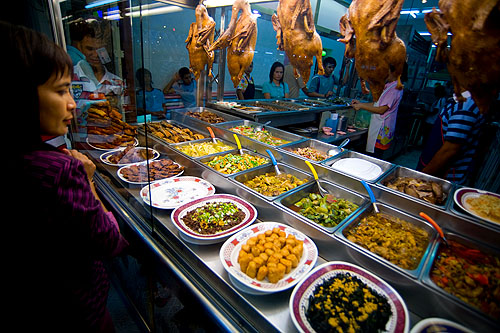

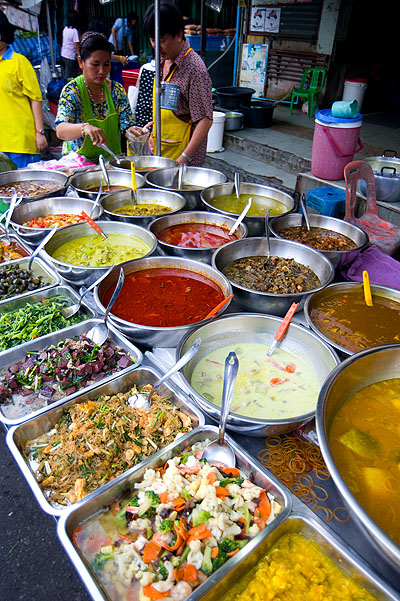
 Operating since 1983, Shoshana must be the longest-standing Israeli restaurant in the Khao San Road area, if not in all of Bangkok. Nowadays there are several places in the area serving pitas, felafel and even shwarma, but I inevitably go back to Shoshana. This used to be partially for the constant stream of Seinfeld re-runs being played there (I've never owned a TV), but was mostly for a delicious break from Thai food.
Operating since 1983, Shoshana must be the longest-standing Israeli restaurant in the Khao San Road area, if not in all of Bangkok. Nowadays there are several places in the area serving pitas, felafel and even shwarma, but I inevitably go back to Shoshana. This used to be partially for the constant stream of Seinfeld re-runs being played there (I've never owned a TV), but was mostly for a delicious break from Thai food. Other than noodles, the greatest contribution the Chinese have made to Thai cooking, at least in my opinion, is khao tom. The Thai words literally mean "boiled rice," but in this case they refer to restaurants that serve a variety Chinese/Thai dishes to order, often with small bowls of watery rice. One of my favourite khao tom places in Bangkok is Khao Tom Jay Suay, an ancient shophouse restaurant in Chinatown. The restaurant is colloquially known as Khao Tom Roy Pee, "100 Year Old Khao Tom," but I was told it's really only about 50 years old.
Other than noodles, the greatest contribution the Chinese have made to Thai cooking, at least in my opinion, is khao tom. The Thai words literally mean "boiled rice," but in this case they refer to restaurants that serve a variety Chinese/Thai dishes to order, often with small bowls of watery rice. One of my favourite khao tom places in Bangkok is Khao Tom Jay Suay, an ancient shophouse restaurant in Chinatown. The restaurant is colloquially known as Khao Tom Roy Pee, "100 Year Old Khao Tom," but I was told it's really only about 50 years old.

 Cambodia isn't generally known as a culinary destination, but I really enjoyed the eats during five recent days in Siem Reap. The quality of the city's foreign cuisine, particularly its French, was much better than that of a huge city like Bangkok. Among other meals, we had a fun lunch at
Cambodia isn't generally known as a culinary destination, but I really enjoyed the eats during five recent days in Siem Reap. The quality of the city's foreign cuisine, particularly its French, was much better than that of a huge city like Bangkok. Among other meals, we had a fun lunch at 

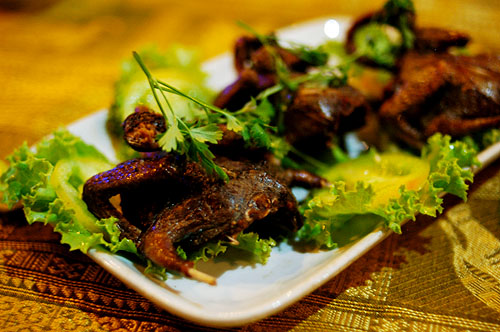

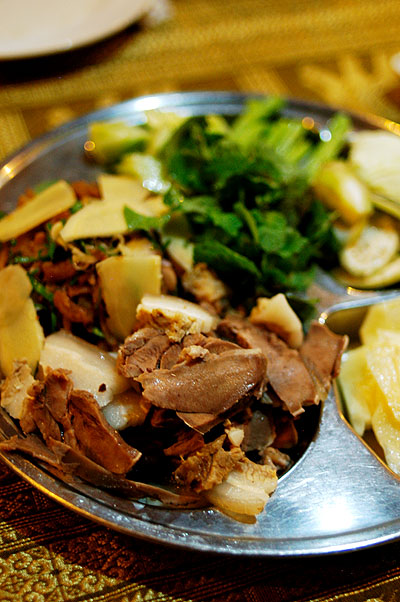


 As mentioned previously, Mae Hong Son was pretty wet, so we spent a lot of our time indoors, much of it eating and drinking. Of all the things we consumed there, I'm pretty sure that the local sweets were the biggest hit among the two chefs. We bought several banana leaf packages of the sweets on a daily basis, and they never seemed to tire of them.
As mentioned previously, Mae Hong Son was pretty wet, so we spent a lot of our time indoors, much of it eating and drinking. Of all the things we consumed there, I'm pretty sure that the local sweets were the biggest hit among the two chefs. We bought several banana leaf packages of the sweets on a daily basis, and they never seemed to tire of them.

